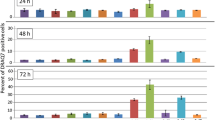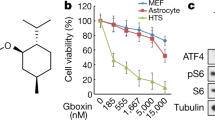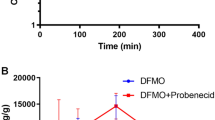Abstract
Acute intermittent porphyria (AIP) or precursor syndrome is a well described neuropathic clinical entity with incompletely known etiology. The most prominent biological abnormalities associated with this syndrome are elevations in serum and hepatic δ-aminolevulinic acid (ALA) and porphobilinogen (PBG). We determined the impact of ALA and PBG on human neuroblastoma and glioblastoma tumor cell survival as measured by the MTT assay. ALA proved to be cytotoxic in neuroblastoma cells, while PBG lacked cytotoxic effects. This cytotoxic effect of ALA could be enhanced by deferoxamine and diminished by heme, presumably through modulation of ALA synthesis. In conclusion, ALA excess may prove to be associated with the development of neuropathy in AIP.
Similar content being viewed by others
References
Granick, and Vanden Schriek, H. G. 1955. Porphobilinogen and delta-aminolevulinic acid in acute porphyria. Proc Soc Exper Biol & Med, 88:270–273.
Sassa, S., and Kappas, A. 1981. Genetic, metabolic and biochemical aspects of the porphyrias. Adv Hum Genet, 11:121–231.
Sweeney, V. P., Pathak, M. A., Ashbury, A. K. 1970. Acute intermittent porphyria, increased ALA-synthetase activity during an acute attack. Brain 93:369–380.
Percy, V. A., Shanley, B. C. 1977. Porphyrin precursors in blood, urine, and cerebrospinal fluid in acute porphyria. S Afr Med J 52:219–222.
Cavanagh, J. B., Mellick, R. S. 1965. On the nature of the peripheral nerve lesions associated with acute intermittent porphyria. J Neurol Neurosurg Psychiat, 28:320–327.
Stein, J. A., Crul, F. D., Valsamis, M., Tschudy, D. P. 1972. Abnormal iron and water metabolism in acute intermittent porphyria with new morphologic findings. Am J Med 53:784–789.
Tschudy, D. P., Perlroth, M. G., Marver, H. S., Collins, A., Hunter, G. Jr., Rechcigl, M. Jr. 1965. Acute intermittent porphyria. The first 2 “overproduction disease” localized to a specific enzyme. Proc Natl Acad Sci 53:841–847.
Perlroth, M. G., Tschundy, D. P., Marver, H. S., Berard, C. W., Ziegel, R. F., Rechcigl, M., Collins, A. 1966. Acute intermittent porphyria: New morphologic and biochemical findings. Am J Med, 41:149–162.
Bloomer, J. R., Bonkovsky, H. L. 1989. The porphyrias. Dis Mon 35:1–53.
Strand, L. J., Felsher, B. F., Redeker, A. G., and Marver, H. S. 1970. Heme biosynthesis in intermittent acute porphyria: Decreased hepatic conversion of porphobilinogen to porphyrins and increased delta-aminolevulinic acid synthetase activity. Proc Natl Acad Sci, USA 67:1315–1320.
Bonkowsky H. L., Tschudy, D. P., Weinbach F. C. 1975. Porphyrin synthesis and mitochondrial respiration in acute intermittent porphyria: Studies using cultured human fibroblasts. J Lab Clin Med, 85:93–102.
Magnussen, C. R., Levine, J. B., Doherty, J. M., Cheesman, J. O., Tschudy, D. P. 1974. Red cell enzyme method for the diagnosis of acute intermittent porphyria. Blood, 44:857–868.
Nunn, A. V. W., Gardner, L. C., Cox, T. M. 1987. Molecular forms of porphobilinogen deaminase in acute intermittent porphyria. A study by western immunoblotting. Q J Med, 64:589–599.
Lannfelt, L., Wetterberg, L., Lilius, L., Thunell, S., Gellerfors, P. 1989. ELISA for measuring porphobilinogen deaminase in human erythrocytes. Clin Chem Acta, 183:227–237.
Russell, V. A., Lamm, M. C. L., Taljarrd, J. J. F. 1983. Inhibition of Na+, K+-ATPase activity by δ-aminolevulinic acid. Neurochem Research, Vol. 8, 11:1407–1415.
Russell, V. A., Lamm, M. C. L., Taljarrd, J. J. F. 1982. Effects of δ-aminolaevulinic acid, porphobilinogen and structurally related amino acids on 2-deoxyglucose uptake in cultured neurons. Neurochem Research, Vol. 7, 8:1009–1022.
Percy, V. A., Lamm, M. L., Taljaard, J. J. F. 1981. δ-aminolaevulinic acid uptake, toxicity, and effect on [14C] δ-aminobutyric acid uptake into neurons and glia in culture. J Neurochem 36:69–76.
Müller, W. E., and Snyder, S. D. 1977. δ-aminolaevulinic acid: Influences on synaptic GABA receptor binding may explain CNS symptoms of porphyria. Ann. Neurol 2:340–342.
Brennan, M. J. W., Cantrill, R. C. 1979. δ-aminolaevulinic acid is a potent agonist for GABA autoreceptors. Nature 280:514–515.
Rubinstein, L. V., Shoemaker, R. H., Paull, K. D., Simon, R. M., Tosini, S., Skehan, P., Scudiero, D. A., Monks, A., Boyd, M. R. 1990. Comparison of in vitro anticancer drug-screening data generated with a tetrazolium assay versus a protein assay against a diverse panel of human tumor cell lines. J Natl Cancer Inst 82:1113–1118.
Wilson, J. K., Sargent, J. M., Elgie, A. W., Hill, J. G., Taylor, C. G. 1990. A feasibility study of the MTT assay for chemosensitivity testsing in ovarian malignancy. Br J Cancer 62:189–194.
Carmichael, J., DeGraff, W. G., Gazdar, A. F., Minna, J. D., Mitchell, J. B. 1987. Evaluation of a tetrazolium-based semiautomated colorimetric assay: Assessment of chemosensitivity testing. Cancer Res 47:936–942.
Bonkowsky, H. L., Tschudy, D. P., Collins, A., Doherty, J., Bossenmaier, I., Cardinal, R., Watson, C. J. 1971. Repression of the overproduction of porphyrin precursors in acute intermittent porphyria by intravenous infusion of hematin. Proc Natl Acad Sci, 68:2725–2729.
Herrick, A. L., McColl, K. E. L., Morre, M. R., Cook, A., Goldberg, A. 1989. Controlled trial of Haem arginate in acute hepatic porphyria. Lancet 1:1295–1297.
Montiero, H. P., Bechara, E. J., Adalla, D. S., 1991. Free radicals involvement in neurological porphyrias and lead poisoning. Mol Cell Biochem, Apr 24; 103 (1):73–83.
Hershko, C., Link, G., and Pinson, A. 1992. Thiolic sarcolemmal proteins are a primary target of iron toxicity in cultured rat heart cells. Proc. ASH, December 4–8, Anaheim, CA, Abstr. 1352, p 340a.
Author information
Authors and Affiliations
Rights and permissions
About this article
Cite this article
Helson, L., Braverman, S. & Mangiardi, J. δ-Aminolevulinic acid effects on neuronal and glial tumor cell lines. Neurochem Res 18, 1255–1258 (1993). https://doi.org/10.1007/BF00975044
Accepted:
Issue Date:
DOI: https://doi.org/10.1007/BF00975044




